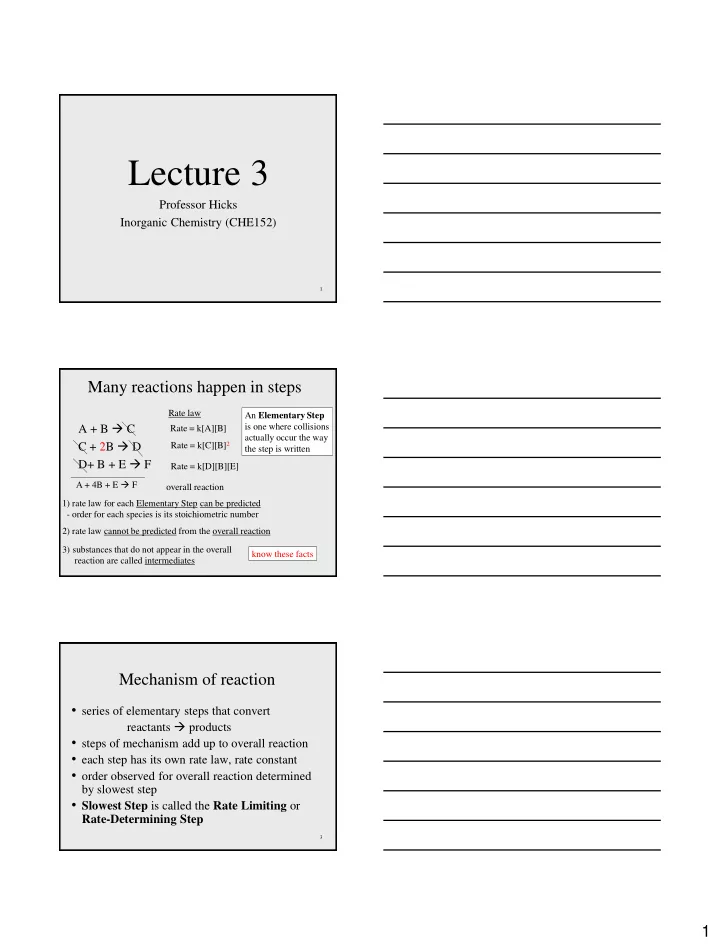

Lecture 3 Professor Hicks Inorganic Chemistry (CHE152) 1 Many reactions happen in steps Rate law An Elementary Step A + B C is one where collisions Rate = k[A][B] actually occur the way C + 2B D Rate = k[C][B] 2 the step is written D+ B + E F Rate = k[D][B][E] A + 4B + E F overall reaction 1) rate law for each Elementary Step can be predicted - order for each species is its stoichiometric number 2) rate law cannot be predicted from the overall reaction 3) substances that do not appear in the overall know these facts reaction are called intermediates Mechanism of reaction • series of elementary steps that convert reactants products • steps of mechanism add up to overall reaction • each step has its own rate law, rate constant • order observed for overall reaction determined by slowest step • Slowest Step is called the Rate Limiting or Rate-Determining Step 3 1
Molecularity • for an elementary step molecularity (order) is the number of molecules that actually collide third order (termolecular) reactions 2 molecules are not common because collision bimolecular or molecularity = 2 of three molecules is not common a second order reaction Overall Reactions • Many reactions must happen in series of steps C 6 H 12 O 6 + 6O 2 6CO 2 + 6H 2 O • To occur in a single step 1 C 6 H 12 O 6 and 6O 2 would have to simultaneously collide – very unlikely • Observed rates for the overall reactions with many steps can be very complicated/unpredictable rate determining step Rate law A + B C (fast) Rate = k[A][B] C + 2B D Rate = k[C][B] 2 (slow) D+ B + E F (fast) Rate = k[D][B][E] A + 4B + E F Rate = k[C][B] 2 overall reaction 1) if one step is much slower than all the others then it is known as the rate determining step 2) The rate observed for the overall reaction is determined by the rate-determining step 6 2
7 rate-determining step narrow part funnel like rate limiting step 8 3
9 10 1
11 12 2
13 14 3
by the rate limiting step 15 16 4
17 5
Rate of reverse reaction say a reaction happens in one elementary step A + B C + D as C and D form the Collision Model says they can react to reform A+B the rate laws are: rate forward reaction = k f [A][B] rate reverse reaction = k r [C][D] Approaching equilibrium rate forward = k f [A][B] rate reverse = k r [C][D] initially if you only add reactants [C]=0 and [D]=0 so backward rate =0 but as a C and D build up reverse reaction speeds up and A and B are declining so as forward reaction slows eventually they will become equal concentrations stop changing!!! Equilibrium Constant • when rates become equal rate forward = rate reverse k f [A][B] = k r [C][D] k f [C][D] = k r [A][B] [C][D] K eq = K eq is called the equilibrium constant [A][B] • When the reactant and product calculate to the value of the equilibrium constant the reaction appears to have stopped! • substantial amounts of reactants may remain 1
Equilibrium is Dynamic • Equilibrium is the condition where the rates of the forward and reverse reactions are equal - it is dynamic • Many reactions reach equilibrium with substantial amounts of reactants present Limiting reagent is a theoretical maximum not always achieved • once the reaction reaches equilibrium, the concentrations remain constant because reactants and products are consumed and made at the same rate • rates of forward and backward reaction are NOT zero 1) People constantly are leaving both bar and dance floor Bar Dance Floor 2) Number of people at both is constant because rates are equal 3) # people bar # people dance floor dynamic equilibrium equilibrium equal • but that does not mean the concentrations of reactants and products are equal • some reactions reach equilibrium only after almost all the reactant molecules are consumed – we say the position of equilibrium favors the products • other reactions reach equilibrium when only a small percentage of the reactant molecules are consumed – we say the position of equilibrium favors the reactants 2
Recommend
More recommend